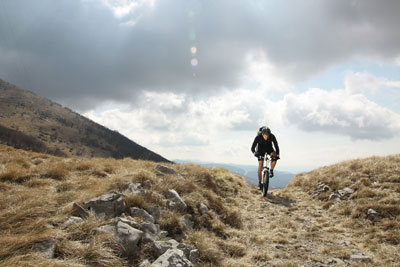
Fuelling your body for mountain biking and backcountry skiing runs parallel to fuelling your body for survival at upper elevations.
Fuelling your body for mountain biking and backcountry skiing runs parallel to fuelling your body for survival at upper elevations. The principles are the same as with any other athletic activity, but somewhere along the line, we seem to get caught up on increasing sugar intake, thinking this is the best means of energizing our bodies and minds. We don’t consider that nutrition must be thought of, and implemented, differently when you’re fuelling your body and mind at higher altitudes.
 |
|
| Understanding requirements and injuries common to sports at upper elevations allows chiropractors to deliver the best health care to the athlete. Advertisement
|
The most important principle to remember is that your blood sugar needs to be balanced, both prior to and during ascent; at the highest altitudes prior to descent; and then for at least an additional 48 hours following the descent. Choosing the tactic to eat or drink too much sugar – or sugar-loaded sport drinks – increases adrenal gland stress, causes an overproduction of insulin, upsets the stomach and creates blood sugar crashes along with an outbreak of altitude mountain sickness (AMS).
AMS is a relatively benign, and usually self-limited, condition that occurs most commonly above 2,500 metres (8202 feet).
According to Smith (2006), the diagnosis is given to patients who arrive at a higher altitude and exhibit headaches, along with at least one of the following indicators: anorexia; nausea or vomiting; fatigue or weakness; dizziness or lightheadedness; and difficulty in sleeping. Symptoms usually occur within several hours, but are typically able to resolve themselves over the course of 48 to 72 hours. Prevention primarily hinges on a gradual ascent to upper altitudes, although specific nutrition guidelines can be considered if a more abrupt ascent is unavoidable.
NUTRITION PRIOR TO ASCENT
On the day before an ascent, reducing raw food intake, eating white chocolate-coated peanuts or macadamia nuts, and drinking more sun-dried sea salt water such as coconut water, or having a balanced breakfast the day of ascent, are two strategies that can be used to assist in the prevention of AMS. A balanced breakfast generally consists of lean protein (that is, cooked chicken, egg whites, fish or turkey), carbohydrates (for instance, quinoa, millet or couscous) and essential fats (such as flaxseed, almonds, peanuts or sesame) consumed one hour before the ascent. Additionally, lightly salting the breakfast meal may, in fact, enhance the body’s ability to absorb water and keep its electrolytes in balance.
ASCENT AND DESCENT
During mountain travel – during ascent, at the arrival of the highest altitude, and during descent – it is recommended you modify your diet to include items such as organic peanut butter and jam on whole-wheat pitas; white chocolate macadamia cookies; perogies; sea salt in water (i.e., 1/3 teaspoon sun-dried sea salt per litre of water, 1/5 pinch of sea salt per one bottle of water, or finger dip and drink sea salt water); sea-salt gluten-free sweet potato chips; and coffee-flavored gel packs. Mountain bikers and skiers tend to loose sodium when they are under physical stress, or when they consume too much water leading to hyponatremia (a disturbance in sodium levels). By adding small carbohydrate-based snacks with salt to your diet, you will be able to keep the electrolytes balanced and guard against cramping.
ARRIVAL AT BASE LEVEL
Upon descent to the lowest altitude, the nutrition regime for mountain travel (ascent and descent) stops. Once you arrive at the final base level, body treatment usually consists of heat therapy for thigh muscles; cold packs wrapped around knee joints; going for a swim in the lake or pool; chiropractic care; therapeutic massage; stretching; drinking chocolate milk and having a balanced dinner consisting of, for instance, three ounces of chicken, half a cup of quinoa and two teaspoons of fish oil.
Balancing one’s nutritional intake for alpine sports is the key to unlimited endurance with minimal to no consequence of experiencing AMS 48 hours after arrival at the highest altitude. Oxygen administration should be considered a treatment option for individuals with respiratory and pulse irregularities.
Mountain bikers and backcountry skiers are at risk for injuries and illness because of the mountainous region where they participate in their sport. Proper preparation for exercising at different elevations is imperative to prevent AMS and sugar crashes. Worsening headache or respiratory symptoms should alert the athlete to possible altitude illness. Understanding injuries common to sports at upper elevations allows chiropractors to deliver the best health care to the athlete.
SOURCES
- Schneider M, Bernasch D, Weymann J, et al. Acute mountain sickness: influence of susceptibility, pre-exposure and ascent rate. Med Sci Sports Exerc 2002; 34(12):1886-91.
- Smith, Larry. Alpine Climbing: Injuries and Illness. Phys Med Rehabil Clin N Am 2006; 17(1): 633-644.
- Sutton JR, Coates G, Houston C. The Lake Louise consensus in the definition and quantification of altitude illness. In: Sutton JR, Coates G, Houston C, editors. Hypoxia and mountain medicine. Burlington (VT): Queen City Press; 1992. P. 327-30.
 |
|
Dr. Emily Roback is a chiropractor with Iron Mountain Chiropractic, practising in aviation chiropractic. Her aviation patients have inspired her to pursue a mountain ski guide certificate and private pilot licence to work in the heli-ski industry. Outside of clinic hours, she works as a bike/ski patroller and course instructor for Ride Guide Chiropractor – an online video course for health professionals. Dr. Roback can be contacted at roback@doctor.com.
Print this page